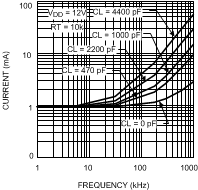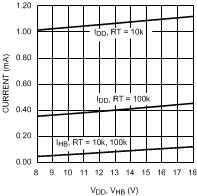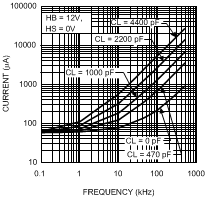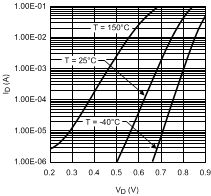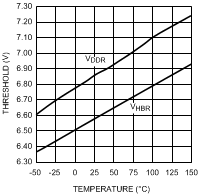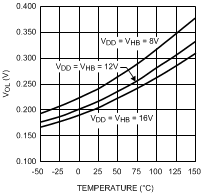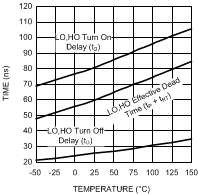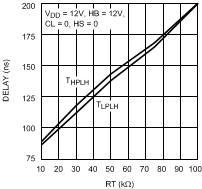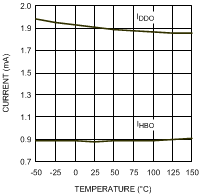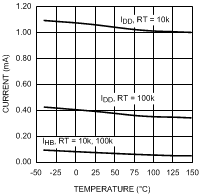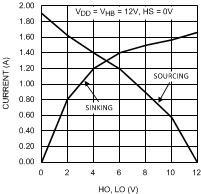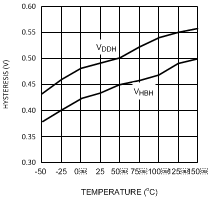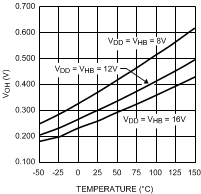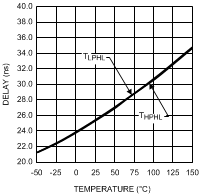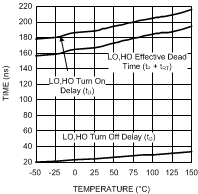SNOSBA3D June 2011 – May 2015 SM74104
PRODUCTION DATA.
- 1 Features
- 2 Typical Applications
- 3 Description
- 4 Revision History
- 5 Pin Configuration and Functions
- 6 Detailed Description
- 7 Application and Implementation
- 8 Power Supply Recommendations
- 9 Layout
- 10Device and Documentation Support
Package Options
Mechanical Data (Package|Pins)
Thermal pad, mechanical data (Package|Pins)
Orderable Information
Specifications
5.1 Absolute Maximum Ratings
over operating free-air temperature range (unless otherwise noted) (1)| MIN | MAX | UNIT | ||
|---|---|---|---|---|
| VDD to VSS | –0.3 | 18 | V | |
| VHB to VHS | –0.3 | 18 | V | |
| IN to VSS | –0.3 | VDD + 0.3 | V | |
| LO Output | –0.3 | VDD + 0.3 | V | |
| HO Output | VHS – 0.3 | VHB + 0.3 | V | |
| VHS to VSS | –1 | 100 | V | |
| VHB to VSS | 118 | V | ||
| RT to VSS | –0.3 | 5 | V | |
| Tstg Storage Temperature Range | –55 | 150 | °C | |
| Maximum Junction Temperature | 150 | °C | ||
(1) Stresses beyond those listed under Absolute Maximum Ratings may cause permanent damage to the device. These are stress ratings only, which do not imply functional operation of the device at these or any other conditions beyond those indicated under Recommended Operating Conditions. Exposure to absolute-maximum-rated conditions for extended periods may affect device reliability.
5.2 ESD Ratings
| VALUE | UNIT | ||||
|---|---|---|---|---|---|
| V(ESD) | Electrostatic discharge | Human-body model (HBM), per ANSI/ESDA/JEDEC JS-001(1) | All pins except 2, 3, and 4 | ±2000 | V |
| Pins 2, 3, and 4 | ±500 | ||||
(1) JEDEC document JEP155 states that 500-V HBM allows safe manufacturing with a standard ESD control process. Manufacturing with less than 500-V HBM is possible with the necessary precautions.
Recommended Operating Conditions
over operating free-air temperature range (unless otherwise noted)| MIN | MAX | UNIT | ||
|---|---|---|---|---|
| VDD | 9 | 14 | V | |
| HS | –1 | 100 | V | |
| HB | VHS + 8 | VHS + 14 | V | |
| HS Slew Rate | 50 | V/ns | ||
| Junction Temperature | –40 | 125 | °C | |
5.3 Thermal Information
| THERMAL METRIC(1) | SM74104 | UNIT | ||
|---|---|---|---|---|
| D | DPR | |||
| 8 PINS | 10 PINS | |||
| RθJA | Junction-to-ambient thermal resistance | 114.5 | 37.9 | °C/W |
| RθJC(top) | Junction-to-case (top) thermal resistance | 61.1 | 38.1 | |
| RθJB | Junction-to-board thermal resistance | 55.6 | 14.9 | |
| ψJT | Junction-to-top characterization parameter | 9.7 | 0.4 | |
| ψJB | Junction-to-board characterization parameter | 54.9 | 15.2 | |
| RθJC(bot) | Junction-to-case (bottom) thermal resistance | - | 4.4 | |
(1) For more information about traditional and new thermal metrics, see the IC Package Thermal Metrics application report, SPRA953.
5.4 Electrical Characteristics
Over operating junction temperature range, VDD = VHB = 12 V, VSS = VHS = 0 V, RT = 100 kΩ, no load on LO or HO, unless otherwise specified.| PARAMETER | TEST CONDITIONS | MIN | TYP | MAX | UNIT | |
|---|---|---|---|---|---|---|
| SUPPLY CURRENTS | ||||||
| IDD | VDD Quiescent Current | LI = HI = 0V | 0.4 | 0.6 | mA | |
| IDDO | VDD Operating Current | f = 500 kHz | 1.9 | 3 | mA | |
| IHB | Total HB Quiescent Current | LI = HI = 0V | 0.06 | 0.2 | mA | |
| IHBO | Total HB Operating Current | f = 500 kHz | 1.3 | 3 | mA | |
| IHBS | HB to VSS Current, Quiescent | VHS = VHB = 100V | 0.05 | 10 | µA | |
| IHBSO | HB to VSS Current, Operating | f = 500 kHz | 0.08 | mA | ||
| INPUT PINS | ||||||
| VIL | Low Level Input Voltage Threshold | 0.8 | 1.8 | V | ||
| VIH | High Level Input Voltage Threshold | 1.8 | 2.2 | V | ||
| RI | Input Pulldown Resistance | 100 | 200 | 500 | kΩ | |
| TIME DELAY CONTROLS | ||||||
| VRT | Nominal Voltage at RT | 2.7 | 3 | 3.3 | V | |
| IRT | RT Pin Current Limit | RT = 0V | 0.75 | 1.5 | 2.25 | mA |
| TD1 | Delay Timer, RT = 10 kΩ | 58 | 90 | 130 | ns | |
| TD2 | Delay Timer, RT = 100 kΩ | 140 | 200 | 270 | ns | |
| UNDER VOLTAGE PROTECTION | ||||||
| VDDR | VDD Rising Threshold | 6.0 | 6.9 | 7.4 | V | |
| VDDH | VDD Threshold Hysteresis | 0.5 | V | |||
| VHBR | HB Rising Threshold | 5.7 | 6.6 | 7.1 | V | |
| VHBH | HB Threshold Hysteresis | 0.4 | V | |||
| BOOT STRAP DIODE | ||||||
| VDL | Low-Current Forward Voltage | IVDD-HB = 100 µA | 0.60 | 0.9 | V | |
| VDH | High-Current Forward Voltage | IVDD-HB = 100 mA | 0.85 | 1.1 | V | |
| RD | Dynamic Resistance | IVDD-HB = 100 mA | 0.8 | 1.5 | Ω | |
| LO GATE DRIVER | ||||||
| VOLL | Low-Level Output Voltage | ILO = 100 mA | 0.25 | 0.4 | V | |
| VOHL | High-Level Output Voltage | ILO = –100 mA VOHL = VDD – VLO |
0.35 | 0.55 | V | |
| IOHL | Peak Pullup Current | VLO = 0V | 1.6 | A | ||
| IOLL | Peak Pulldown Current | VLO = 12V | 1.8 | A | ||
| HO GATE DRIVER | ||||||
| VOLH | Low-Level Output Voltage | IHO = 100 mA | 0.25 | 0.4 | V | |
| VOHH | High-Level Output Voltage | IHO = –100 mA, VOHH = VHB – VHO |
0.35 | 0.55 | V | |
| IOHH | Peak Pullup Current | VHO = 0V | 1.6 | A | ||
| IOLH | Peak Pulldown Current | VHO = 12V | 1.8 | A | ||
5.5 Switching Characteristics
Over operating junction temperature range, VDD = VHB = 12 V, VSS = VHS = 0 V, no load on LO or HO, unless otherwise specified.| Symbol | Parameter | Conditions | Min | Typ | Max | Units |
|---|---|---|---|---|---|---|
| tLPHL | Lower Turn-Off Propagation Delay (IN Rising to LO Falling) | 25 | 56 | ns | ||
| tHPHL | Upper Turn-Off Propagation Delay (IN Falling to HO Falling) | 25 | 56 | ns | ||
| tRC, tFC | Either Output Rise/Fall Time | CL = 1000 pF | 15 | ns | ||
| tR, tF | Either Output Rise/Fall Time (3V to 9V) |
CL = 0.1 µF | 0.6 | µs | ||
| tBS | Bootstrap Diode Turn-Off Time | IF = 20 mA, IR = 200 mA | 50 | ns |
5.6 Typical Performance Characteristics
